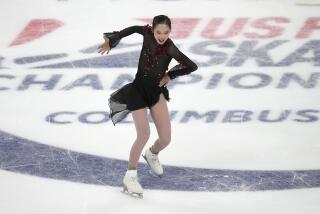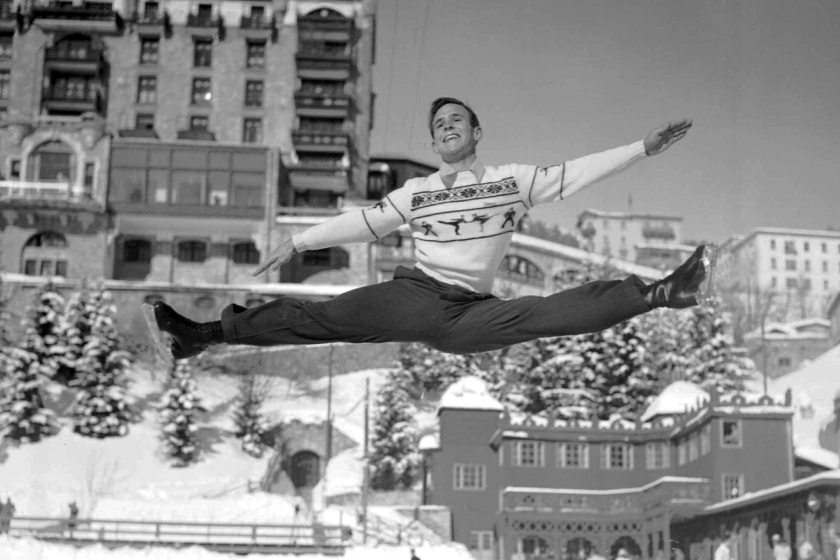Triple Lutz the Next Leap for Nari Nam
- Share via
When you have come from nowhere, when you are a 13-year-old pixie with nerves of steel and a head forged of the same material--How else did you keep skating after you fell so hard that your head bounced on the ice?--when you have finished, despite that horrifying fall, second in your first U.S. Figure Skating Championships and become instantly famous, instantly tabbed as the threat to Michelle Kwan, when you are already rated in a poll as the third most popular athlete in South Korea, then of course everybody wants to know.
Does Naomi Nari Nam have her triple lutz yet?
What do you mean you don’t know what a triple lutz is? You can be sure they do in South Korea. Nari Nam, the little girl from Irvine, was invited to skate an exhibition in Seoul a couple months ago. It was called “Naomi Nari Nam and Friends.”
“I didn’t know any of the friends,” Nari Nam says with a giggle.
But anyway, the triple lutz is the second-most difficult of figure skating’s triple jumps. Since none of the top women are even trying the most difficult triple, the axel, in competition, the triple lutz is the measuring stick to determine a skater’s legitimacy as a world championship and Olympic contender.
When Nari Nam finished a stunning second to Kwan at the 1998 nationals in Salt Lake City, she didn’t do a triple lutz. Her coach, John Nicks, will only let a pupil do a jump in competition if she can complete 80% of them in practice. Last February, Nari Nam was landing the jump only 30% to 40% of the time.
So on a quiet morning inside the frosty rink at the Ice Chalet in Costa Mesa, Nicks instructed Nari Nam to warm up, then try three triple lutzes. She’s hitting 60% to 70% in practice now, Nicks said, and then he winked at Nari Nam and told her to go.
The first jump was high and strong and almost . . . oops, not quite perfect. A bit of a two-footed landing. “I’d give her half credit on that,” Nicks said, then he winked again. Nari Nam skated away and did the jump again. Up, up, twirling, twirling, landing. Yes. One foot on the ice and only one foot. Then another, just about as good. Maybe her leg wobbled at the end but the jump was completed. It was landed.
“Two and a half out of three,” Nicks said. “Not bad.”
But not good enough. Nari Nam said, “I want to do another one.” And she did.
Tonight at the Arrowhead Pond and Saturday at the Sports Arena, Nari Nam will make her hometown debut. She will perform in the “Tom Collins Champions on Ice” tour. Skaters such as Kwan, Oksana Baiul and Nicole Bobek have been performing show routines across the country. After her breakthrough at the nationals, Nari Nam was invited to join the tour on its West Coast swing. No triple lutzes tonight, but the audience will be treated to the breathtaking spins and unexpectedly mature footwork that Nari Nam uses in her show program skated to music from “The King and I.”
That invitation is just one of the opportunities that has come to Nari Nam since her whirlwind performance in Salt Lake City.
She has appeared on “The Tonight Show with Jay Leno,” flown to New York and was a guest on “The Today Show.” She has been invited to skate in exhibitions everywhere, most notably South Korea, where her grandparents were born and where Nari Nam met aunts and uncles and cousins she’d never even known about.
But even as Nari Nam has impressed the figure skating world with her skating, she has also become the focus of debate about figure skating’s new age rules, which could keep her out of the world championships in 2000 and 2001, a result that might hinder her ability to gain the necessary worldwide exposure and experience she’d need for the 2002 Winter Olympics in Salt Lake City.
Nari Nam won’t turn 14 until July 6. She would have to turn 15 before July 1 to qualify for the senior world championships or medal at the junior world championships. Sarah Hughes, who finished fourth at the 1998 U.S. nationals and who is only six weeks older than Nari Nam, was allowed to represent the U.S. at the 1999 worlds in place of Nari Nam by virtue of medaling at the 1999 junior worlds, a competition Nari Nam was also ineligible for because she was born five days late.
There have been changes made to the skating calendar so the 2000 junior world championships will be held only two weeks before the senior world championships. This leaves Nicks and his eager, talented student with a problem.
They could try to petition for a change in the International Skating Union age rules. Because the rest of the world isn’t eager to help the United States bring another female champion to the medal podium, Nicks says that “it is unlikely we’ll get help that way.”
So Nicks and Nari Nam are working with the idea that she will compete at the junior international competitions she has been nominated to by the U.S. Figure Skating Assn.--the Junior Grand Prix in Montreal Sept. 29-Oct. 3 and the Junior Grand Prix in Nagano, Japan, Nov. 18-21. She would skate at the U.S. nationals in February and at the junior world championships in Germany in March, then if Nari Nam medals there, and if she had medaled at U.S. nationals, she would fly home from Germany for a day or two and then head to the 2000 World Championships in Brisbane, Australia.
And so, because of the age rule, Nari Nam will probably end up spending more time in practice, in traveling, in competitions, to achieve goals she feels ready to achieve. That’s the opposite of what the rule is intended to do. What it comes down to is that rules or not, you can’t keep talent shut in a box until a birthday passes.
Diane Pucin can be reached at her e-mail address: [email protected]
More to Read
Go beyond the scoreboard
Get the latest on L.A.'s teams in the daily Sports Report newsletter.
You may occasionally receive promotional content from the Los Angeles Times.






